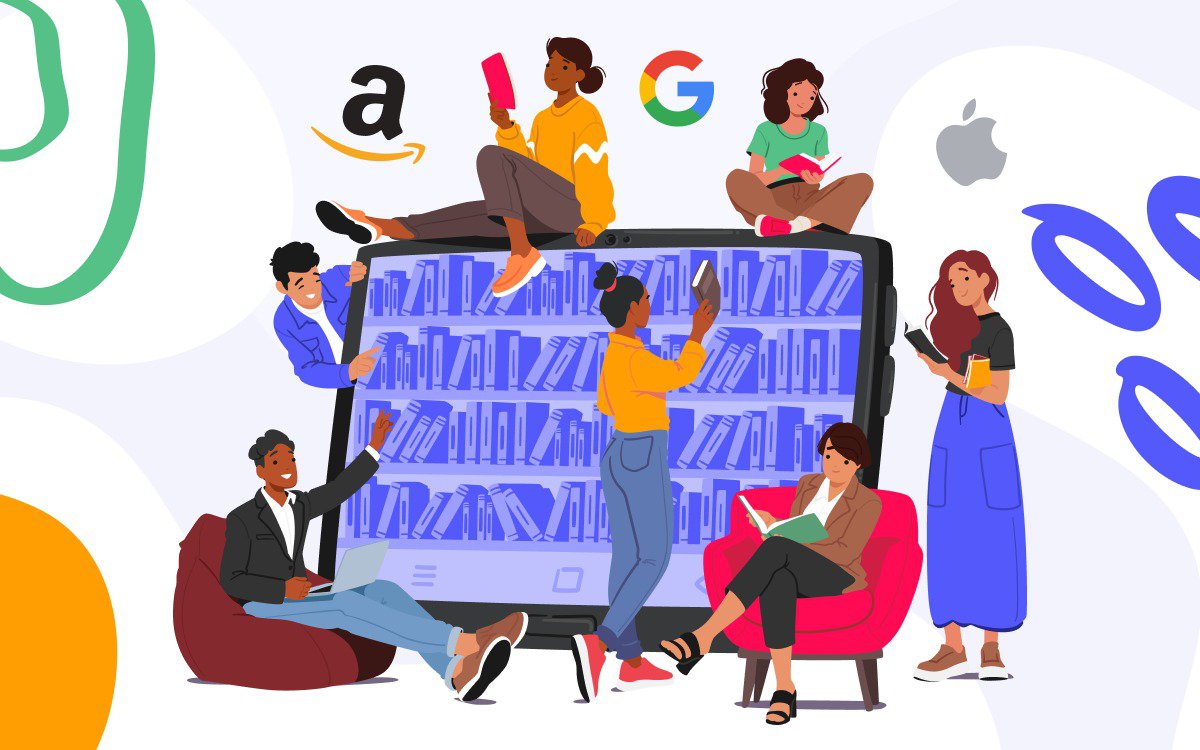Employee Training Examples: How Apple, Amazon & Google Do It

Every company needs to establish an employee training platform at some point. But how to do that when there are so many different types of training out there? The top global companies presented in this article also had to answer this question, and their approaches could be one of the reasons for their success.
Let’s explore how Apple, Amazon, and Google built their corporate training programs, which enhance performance, providing employee training examples of effective learning processes for countless other companies worldwide.
Employee training examples at Apple
Apple is one of the most influential companies. It began as a garage startup and grew into a global enterprise with 535 stores around the world and more than 100,000 employees. Apple is known for its rigorous training programs that ensure all employees are aware of and keep up with a lengthy list of procedures. How do they manage this complex training process with such a vast workforce?
Apple University
Apple has its own Apple University. It was established in 2008 by Steve Jobs “to teach what it meant to be an Apple employee, educating them about the company’s culture and history,” according to The Guardian. All the training happens on campus, and the university has academic staff and instructors. However, the classes at the university are not mandatory but rather recommended, offering robust learning opportunities. Employees sign up for them through an internal website available only to Apple staff members.

Despite offline optional courses, all Apple employees should still complete the obligatory annual Business Conduct training tailored to their business line. This training covers topics such as workplace behaviors, conflicts of interest, gifts, confidentiality, competition, privacy, and other essential laws and values. In addition, employees have mandatory annual or bi-annual training on Privacy, Respect at Apple, and Inclusion and Diversity, which L&D teams help facilitate, ultimately boosting employee performance.
Customized training programs
Apple also has different training programs for every type of employee and every occasion. Special onboarding courses for new employees include Product Knowledge Training (by the way, we’ve already made a guide on that Product Knowledge Training guide) and Cultural Training, where new hires learn Apple’s core values. They offer Retail Employee Training that includes courses on communication, empathy, and customer experience. Engineers and developers benefit from leadership, technical training, and opportunities to learn new skills with the guidance of L&D teams, thus enhancing employee performance.
We found it fascinating that they have on-site training for customers called Today at Apple. During these meetings, trained team members conduct teaching sessions from basics and how-to lessons to professional-level programs. Moreover, this training is absolutely free. For example, an iPhone user interested in photography can start with six How-To sessions that cover shooting, organizing, editing, and more. More advanced photographers can join experiential Photo Walks that leave the store to dive into techniques, including light and shadow, portraits, and storytelling. At the same time, this initiative serves as hands-on training for Apple Specialists on Apple products and interaction with customers.
They also encourage peer-to-peer learning. For that, they use an app called Loop so that workers can share their achievements and learning processes with others through short videos. “We use auto-translate and everybody in the world can see what Tom in Regent Street (in London) is doing. It’s a huge unlock, just getting all the stores to talk to one another,” said former Apple Senior Vice President of Retail Angela Ahrendts to Vogue Business in 2019.
Employee training examples at Amazon
Amazon took it a step further from Apple and decided to train its employees and invest in creating a highly skilled workforce. In 2022, leaked documents showed a 150% annual employee turnover among mostly hourly-paid and warehouse workers. Despite Amazon’s upskilling program starting back in 2019, the leaked information could indicate why the program was started in the first place.
Upskilling program
According to the company’s website, Amazon conducted research based on its workforce and the analysis of US hiring. The fastest-growing, highly skilled jobs were data mapping specialist, data scientist, solutions architect, business analyst, logistics coordinator, process improvement manager, and transportation specialist. Following the program plan, L&D teams ensure Amazonians from all backgrounds can access training to move into qualified technical and non-technical roles across the company’s corporate offices, tech hubs, fulfillment centers, retail stores, and transportation networks or pursue career paths outside Amazon. This initiative is crucial in enhancing employee performance. Since then, the company has invested nearly $2 billion in developing its employees, aspiring to be “Earth’s best employer and Earth’s safest place to work”.

Nine free skills training programs help Amazon employees land higher-paying roles, some of which are designed to impart new skills:
Career Choice
Career Choice is a pre-paid tuition program that helps hourly employees to further their education. In this program, Amazon pre-pays college tuition and funds high school completion, GEDs, and ESL proficiency certifications.
Surge2IT
Surge2IT is open to entry-level IT employees who want to advance in their careers. This entirely self-service program is made up of 40 hours of content, allowing participants to work through it at their own pace. The content covers Amazon networks, devices, tools, and technology, and L&D teams focus on leadership and professional development to enhance employee performance.
AWS Training and Certification
This program is a dedicated business in AWS that equips organizations and learners of all skill levels, roles, and backgrounds with the knowledge and practical skills to innovate in the AWS Cloud. The program offers more than 600 free digital courses created by AWS experts, as well as classroom training sessions with AWS-accredited instructors.
AWS Intelligence Initiative
This program helps engineers launch a technical career at Amazon via paid training. The program follows a centralized structure, with all participants undergoing onboarding, technical training, and job rotations across various AWS internal teams. Once admitted, participants engage in a 12- to 24-month development program to learn about AWS operational culture, enhance their technical skills, and obtain on-the-job experience. Engineers rotate working on different AWS service teams alongside experienced AWS engineers to build and operate AWS services. Such structured training is vital for improving employee performance.
Besides the costly employee development program, Amazon has extensive onboarding and necessary training about product knowledge, privacy and security, and other essential topics. One of these trainings, called Cybersecurity Awareness, is publicly available to everyone and can even be exported as a SCORM file, allowing L&D teams to import it into your company’s LMS.
If you are still looking for an LMS, we recommend IZI LMS for Confluence. This app allows you to provide your workers with cybersecurity training designed by Amazon’s chief security officer. This way you can enhance the employee training process and performance effectively.
Employee training examples at Google
Known globally as the most used search engine, Google conducted a few successful L&D experiments, making Google the company with the most employee-led L&D strategy among those presented here.
The G2G program
Google believes that employee-to-employee training is an effective way to promote a learning culture. As it states on their website, “at Google, 80% of all tracked trainings are run through an employee-to-employee network called “g2g” (Googler-to-Googler).” Volunteers—referred to internally as “g2g’ers”—contribute in various ways, including teaching courses, offering one-on-one mentoring, and developing learning materials. These learning opportunities represent a wide range of departments across Google. However, Google continues to engage vendors—and a limited number of internal professional trainers—for select classes, primarily those that are highly specialized or tailored for executives. L&D teams help to manage these trainings, which are provided and tracked through an internally created learning management system (LMS), fostering improved employee performance.
Whisper course
Google’s L&D team shifted from assigning lengthy training sessions to a microlearning approach, essentially a set of compact e-learning modules designed to reduce learner fatigue and enhance employee performance. They send weekly email nudges to managers to remind them of tasks needed to implement their training. These nudges are called Whisper Courses and are like a quick whisper into the manager’s ear. The main point is to send them at the right time, for example, during onboarding. The emails provide suggestions for improving workplace culture. Examples include tips on being more present in meetings, building trust, and enhancing feedback.

So what’s the best corporate training program?
The diverse employee training examples of the companies presented here are all unique yet effective, contributing to low annual turnovers. Some prefer offline classroom training, while others prefer peer-to-peer online learning. The best option for your company depends on various factors, such as the number of employees, L&D budget, company needs, and industry. The right employee training program can significantly boost employee performance.
However, if your company uses Confluence and wants to establish an employee training program in Confluence or consolidate all data in one place, consider IZI LMS for Confluence! When building corporate training in Confluence, IZI provides the tools to implement the best practices from these employee training examples. Try IZI for free for a whole month!


















